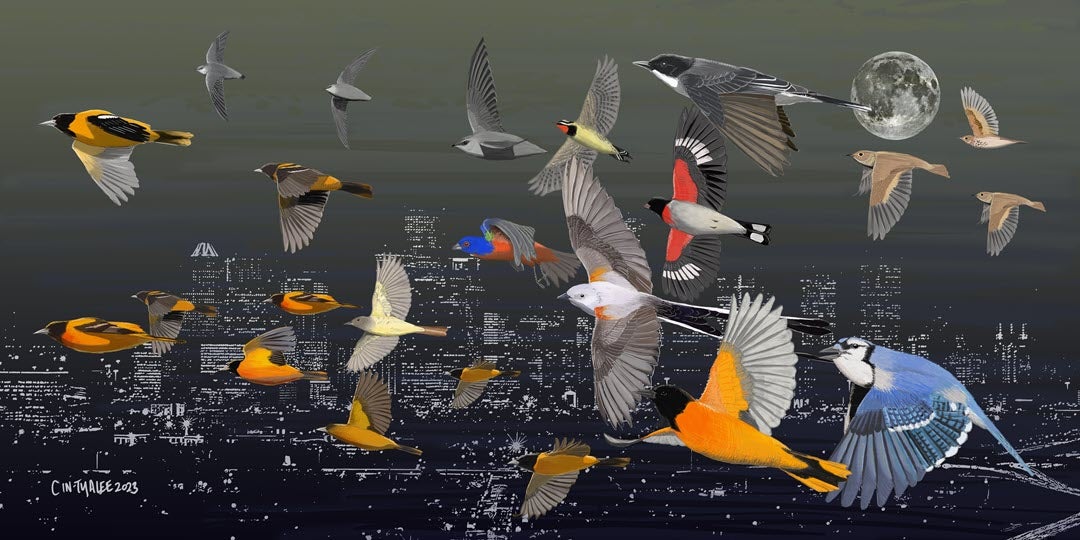
Over the last twenty years, Dr. Cin-Ty Lee and a countless number of student and community member volunteers have recorded 275 species of birds on Rice’s campus. The Lynn R. Lowrey Arboretum is critical habitat for local residents, as well as neotropical migratory birds.
Dr. Lee has been an advocate for the continued conservation of our campus green space and has described the importance of the Arboretum to the support of our local and migratory species:
“As dawn breaks, an armada of buntings, each buzzing and fluttering, begins their descent, first one-by-one, then by twos, then all together, and soon thereafter, the bushes are adorned with little blue angels. These are indigo buntings. Then in the evening, after the sun sets, and incapable of suppressing their primordial yearnings, the indigos re-assemble, as if on cue, and take to the skies to continue their southward journey, under the gaze of the stars, to a land far away. This is fall migration.
As summer ends in the far north, daylight hours begin to wane, and temperatures begin to drop. Hundreds of millions of birds, of a multitude of species, are forced to head south to the warmer climes of the tropics, thousands of miles away. Some of these birds, born into this world just a few months earlier, are embarking on this journey for the first time. Others are repeating this epic journey for the second or third or even fourth time. With no map to read except for an innate sense of place, time and direction passed on through the genetics of previous generations, they arrive on time, at the right destination, almost without fail. In the spring, as long days of sunlight return in the north, these tropical migrants reverse their journey and spread north, populating every nook and cranny of the continent to take advantage of the explosion of photosynthesis and proliferation of food to raise the next generation. Birds have been following these transhemispheric rituals, twice a year, for millions of years, over countless generations.
These migratory marathons are a matter of life and death. In the spring, it is a race to claim territory up in the north and raise young before the days shorten, forcing them to head back south. To save time, many birds fly by the night, stopping during the day to search for food and refuel. Some birds are in such a rush that they choose to fly across the Gulf of Mexico, and over this vast expanse of ocean, they cannot stop until they reach the coast of Texas, where they descend out of exhaustion.
Refueling rest stops are critical along these migratory routes, but over the last hundred years, humans have transformed the landscape, much of the original native habitats destroyed and replaced with agricultural fields or the concrete landscapes of our cities. Waterways have been diverted or redirected, and their riparian edges decimated. There are fewer rest stops now, especially in cities.
Birds migrating over our human built landscape might as well be flying over the Gulf of Mexico. Now, more than ever, small patches of green in cities are thus especially important. Nestled within the fourth largest city in the country, surrounded by urban landscape, the green spaces at Rice offer a brief sanctuary for these migrating birds. Only about 20 or so species make Rice their permanent home. We have resident Great Horned and Screech Owls. Red-bellied and Downy Woodpeckers roam the campus. Grackles, Blue Jays, robins, and House Finches are a daily occurrence. But what makes Rice shine is the many migrating species that pass through. For those migrating birds that happen to find themselves over Houston at dawn, Rice is like an oasis, and the birds funnel in from afar.
In late April or early May, the trees can be adorned with warblers, orioles, buntings and tanagers that have just come across the Gulf. On some days, the migrants seem to fall out of the sky, hundreds of them streaming by at sunrise. In the fall, sparrows from the north descend in the night and scatter across campus. Hawks, sometimes in the tens of thousands, kettle overhead, as they prepare to head south. Sometimes unexpected birds turn up: a majestic Swallow-tailed Kite, soaring Wood Storks, a seafaring Brown Booby, a lost Townsend’s Warbler from the west, a Smith’s Longspur from the Arctic. There is never a day that is not exciting.”
The Arboretum is truly a gem for both birds and bird watchers in the middle of our city.
If you would like to join Cin-Ty to experience our campus birds, we encourage you to join him and the Houston Audubon during their weekly bird walks. The walks are held on campus between the months of September and May on Tuesdays at 7:30 AM. Bird watchers meet at the Owl Deck, an outdoor pavilion located adjacent to Intramural Field 6. For more information, please contact Dr. Cin-Ty Lee at ctlee@rice.edu
